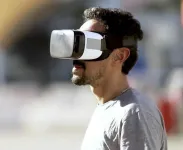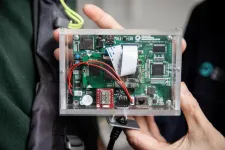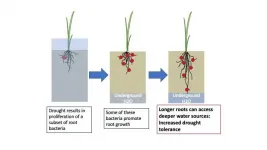(Press-News.org) As any juror will tell you, piecing together a crime from a series of documents tendered in a courtroom is no easy feat, especially when a person's future hangs in the balance.
Delivering the correct verdict on car accident and murder cases is contingent on good spatial awareness, but short of being at the scene of the crime, the room for error is large.
However, thanks to the advent of virtual reality (VR), jurors now have a better chance of making the right decision.
A new study published by the University of South Australia provides overwhelming evidence in favour of using VR in the courtroom, effectively dropping jurors right in the middle of a car accident or murder scene.
A team of UniSA researchers, legal professionals, police and forensic scientists simulated a hit-and-run scene, reconstructing the events with a laser scanner to compare verdicts between 'jurors' using 3D headsets and those relying on photographs from the scene.
The result? Better recall, spatial accuracy and more consistent verdicts in the case of the jurors (30 study participants) using interactive technology.
"Virtual reality also required significantly less effort than using photographs to piece together the sequence of events," says Dr Andrew Cunningham, from UniSA's Australian Research Centre for Interactive and Virtual Environments.
Study participants viewing the scene through a 3D headset were 9.5 times more likely (86.67 per cent) to choose the same verdict - Death by Dangerous Driving - than the group who relied on photographs, who were split 47/53 per cent between a careless driving verdict and dangerous driving verdict.
"Participants who were immersed in the scene were more likely to correctly remember the location of the car in relation to the victim at the time of the accident, whereas it was difficult for people to visualise the scene from still images.
"This provides unequivocal evidence that interactive technology leads to fairer and more consistent verdicts, and indeed could be the future of courtrooms," Dr Cunningham says.
Lead researcher Dr Carolin Reichherzer says site visits are still the gold standard in providing juries with a realistic impression of a scene, but they also have their drawbacks.
"They are expensive - especially in remote locations - and in some cases the site itself has changed, making accurate viewings impossible," Dr Reichherzer says.
Virtual reality has precedence in the court room internationally, with the most famous example in 2019 when the Bavarian State criminal office created an interactive scene of the infamous Auschwitz concentration camp to aid the prosecution's case in a war crimes trial.
A video supplementing this press release is available at https://youtu.be/zQl77dzfm3A
INFORMATION:
Notes for editors
"Bringing the jury to the scene of the crime: memory and decision-making in a simulated crime scene" was rated among the top 5 per cent of papers presented at the 2021 CHI: Conference on Human Factors in Computer Systems, held in Japan in May. The conference is considered the most prestigious in the field of human-computer interaction.
For a copy of the paper please contact candy.gibson@unisa.edu.au
The study was led by UniSA PhD candidate Carolin Reichherzer who has now graduated and is working in Switzerland. UniSA researchers involved in the study included Dr Andrew Cunningham, Professor Bruce Thomas, Professor Mark Billinghurst, Tracey Coleman and Ruochen Cao. University of Adelaide academics and forensic scientists from the Institute of Environmental Science in Auckland also took part in the study.
The discovery of a Roman road submerged in the Venice Lagoon is reported in Scientific Reports this week. The findings suggest that extensive settlements may have been present in the Venice Lagoon centuries before the founding of Venice began in the fifth century.
During the Roman era, large areas of the Venice Lagoon which are now submerged were accessible by land. Roman artefacts have been found in lagoon islands and waterways, but the extent of human occupation of the lagoon during Roman times has been unclear.
Mapping the lagoon floor using sonar, Fantina Madricardo and colleagues discovered 12 archaeological structures aligned in a northeasterly direction for 1,140 metres, in an area of the lagoon ...
Newly-hatched pterosaurs may have been able to fly but their flying abilities may have been different from adult pterosaurs, according to a study published in Scientific Reports.
Pterosaurs were a group of flying reptiles that lived during the Triassic, Jurassic and Cretaceous Periods (228 to 66 million years ago). Due to the rarity of fossilised pterosaur eggs and embryos, and difficulties distinguishing between hatchlings and small adults, it has been unclear whether newly-hatched pterosaurs were able to fly.
Darren Naish and colleagues modelled hatchling flying abilities using previously obtained wing measurements from four established hatchling and embryo fossils from two pterosaur species, ...
Gene therapy in mouse models showed promise in preventing vision loss or blindness from serious retinal injury including optic nerve damage, and from retinal disease including diabetic retinopathy and glaucoma, Mount Sinai researchers report. Their study, published in the July 22 online publication of Cell, could transform treatment for those at risk of major vision loss from retinal degenerative diseases, which currently have no cure.
The researchers focused on retinal ganglion cells, which process visual information by sending images to the brain. These cells can degenerate as a result of retinal injury and retinal disease. ...
Geneticists from Trinity College Dublin have discovered how a specific genetic mutation called H3K27M causes a devastating, incurable childhood cancer, known as diffuse midline glioma (DMG), and - in lab studies working with model cell types - successfully reverse its effects to slow cancer cell growth with a targeted drug.
Their landmark work - just published in leading international journal, Nature Genetics and supported by Worldwide Cancer Research and The Brain Tumour Charity - translates crucial new understanding of the genetics of DMG progression into ...
A form of gene therapy protects optic nerve cells and preserves vision in mouse models of glaucoma, according to research supported by NIH's National Eye Institute. The findings suggest a way forward for developing neuroprotective therapies for glaucoma, a leading cause of visual impairment and blindness. The report was published in Cell.
Glaucoma results from irreversible neurodegeneration of the optic nerve, the bundle of axons from retinal ganglion cells that transmits signals from the eye to the brain to produce vision. Available therapies slow vision loss by lowering elevated eye pressure, however some glaucoma progresses to blindness despite normal eye pressure. Neuroprotective therapies would be a leap forward, meeting ...
Advances in microscopy have enabled researchers to picture loops of DNA strands for the first time. The images reveal how the human genome organises itself in three-dimensional space at much higher resolution than previously possible.
The findings, published in a new study in the journal Molecular Cell, also reveal that the process of DNA being copied into RNA - transcription - indirectly shapes the architecture of the genome. An international team led by Pia Cosma at the Centre for Genomic Regulation (CRG) in Barcelona and Melike Lakadamyali at the Perelman ...
Manipulating RNA can allow plants to yield dramatically more crops, as well as increasing drought tolerance, announced a group of scientists from the University of Chicago, Peking University and Guizhou University.
In initial tests, adding a gene encoding for a protein called FTO to both rice and potato plants increased their yield by 50% in field tests. The plants grew significantly larger, produced longer root systems and were better able to tolerate drought stress. Analysis also showed that the plants had increased their rate of photosynthesis.
"The change really is dramatic," said University of Chicago Prof. Chuan He, who together with Prof. Guifang Jia at Peking University, led ...
A new study showed that a wearable computer vision device can reduce collisions for both people who are blind or those who are visually impaired and using a long cane and/or guide dog by 37 percent, compared to using other mobility aids alone.
People who have visual impairments are at a significantly higher risk for collisions and falls. Commonly used mobility aids like long canes and guide dogs can offer benefits, but come with limitations in effectiveness and costs, respectively. While some electronic devices are marketed direct-to-consumer claiming to warn wearers of surrounding objects, there has been little evidence of their effectiveness in actual daily mobility settings. This is one of the first randomized-controlled trials to look at the potential benefit of the ...
What The Study Did: This study included 647 patients with untreated nonmetastatic prostate cancer (269 patients during the pandemic and 378 from before the pandemic). During the initial COVID-19 lockdown, only 1% of Black men underwent prostatectomy, while 26% of white patients did. Prior to the pandemic, there was no difference in the rate of prostatectomy between the two races (18% of Black men and 19% of white men). The lessons from this study suggest systemic inequities within health care and are likely applicable across medical specialties. Public health efforts are needed to fully recognize the unintended consequence of diversion of cancer resources to the COVID-19 pandemic to develop balanced mitigation strategies as viral rates continue to fluctuate.
Authors: ...
Drought can have a lasting impact on the community of microbes that live in and around roots of rice plants, a team led by UC Davis researchers has found. Root-associated microbes help plants take up nutrients from the soil, so the finding could help in understanding how rice responds to dry spells and how it can be made more resilient to drought. The work is published July 22 in Nature Plants.
The root microbiome of irrigated rice plants goes through a sequence of changes as the plants grow and stabilizes when they flower. The sequence of changes in the root ...



